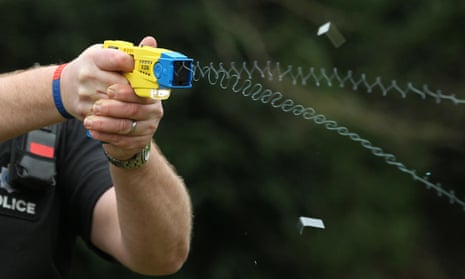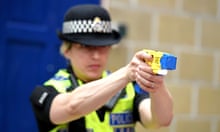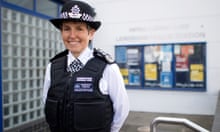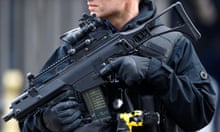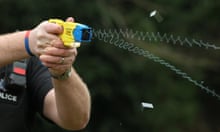Black and mixed-race people in London have been on the receiving end of more than 40% of police Taser use since 2014, despite accounting for less than one in six of the capital’s residents, the Guardian can reveal.
Figures obtained by a freedom of information (FoI) request show police are disproportionately targeting people of black or mixed white and black ethnicity with the electric stun guns, raising fresh concerns of racism in the force.
Between January 2014 and September 2016, 1,530 of a total of 3,815 cases – 40.1% – where police drew, aimed or fired Tasers involved people of black or mixed white and black ethnicities. According to the 2011 census, people from those groups comprise 15.6% of London’s population.
The figures, which come before the expected rollout of a new, more powerful model of Taser gun, also reveal that overall Taser use by the Metropolitan police increased in 2015 and was due for another increase in 2016, based on figures for the first nine months of the year.
Lee Jasper, a race relations activist who was director of policing and equalities for the former London mayor Ken Livingstone, said the latest figures showed that the police systematically targeted black people.
“Black people are disproportionately charged for offences; we are disproportionately refused bail; we are disproportionately found guilty and disproportionately sentenced,” he said. “We have got massive disproportionality right throughout the system, of which Tasering is just one aspect.
“The working culture of the Met police service is one that deems black people to be mad, bad or criminal. The mayor of London needs to take urgent action to redress the resurgence of institutional racism within the MPS that is driving this disproportionately.”
The Met’s figures include all the times that officers drew, aimed or fired Tasers while on duty, although the weapons were only discharged in 13% of cases. They correspond with a FoI request by the BBC from 2015, showing that across England black people were three times more likely to be Tasered than white people.
Data collected by the mayor of London’s office shows that people of black or mixed race ethnicity have the least confidence in the police out of all Londoners.
Diane Abbott, Labour’s shadow home secretary, said the use of Tasers aggravated tensions between police and the public. “There is something inherently wrong with how Tasers are being used, and there are no assurances that their use does not disproportionately impact BME communities,” she said.
“Tasers are not some sort of panacea and there have been too many incidents where Tasers have led to unnecessary deaths.
“Amber Rudd’s decision to provide this potentially lethal instrument to any police officer who wants one will only add to historic tensions between communities and the police.”
Enfield had a higher than average proportion of black people involved in Taser incidents. Tasers were used against black people 55 out of 131 times in the period covered by the FoI. The area’s MP, Kate Osamor, called the findings “deeply alarming”.
“When contrasted with the ethnic makeup of the borough, these figures clearly show non-whites being disproportionately affected,” she said.
“This data reflects a wider perception of discrimination that is felt by the black community. Relations between police and the black community have been further strained owing to the high number of stop and searches, harassment cases and deaths in custody. These incidents only seek to further weaken the relationship between law enforcement and those they purport to protect.”
The Met defended its policies for Taser use, insisting that “the ethnicity of the person is completely irrelevant” when officers consider whether to use force.
“Tasers are carried by specially trained Metropolitan police officers and are used when the safety of the public or the officer is at risk,” a Met spokesman said.
“The Metropolitan police service engages with communities regarding use of force by its officers and specifically regarding the carriage and use of Taser. The current level of deployment is deemed to be appropriate to the threat and risk faced by officers, doing their duty to protect Londoners.
“Officers know that any use of force – which includes the use of Taser – must be entirely justified and that they may be asked to account for their actions.”
There is growing evidence that black people are treated differently in various stages of the criminal justice system. Early findings from an ongoing investigation by David Lammy, the Labour MP for Tottenham, show that for every 100 white women handed custodial sentences at crown courts for drug offences, 227 black women are imprisoned. For every 100 white men jailed, 141 black men receive prison time.
“These emerging findings raise difficult questions about whether ethnic minority communities are getting a fair deal in our justice system,” Lammy said at the time.
Police use of Tasers drew attention last August after the death of Dalian Atkinson, a former Aston Villa footballer, outside his family’s home. Two West Mercia police officers were put under criminal investigation after Atkinson was Tasered three times and suffered a cardiac arrest.
More recently, police in Bristol were investigated by the Independent Police Complaints Commission after Tasering their own race relations adviser. In scenes captured on video, Judah Adunbi, 63, was Tasered outside his home when officers apparently mistook him for a wanted man. Adunbi later said that he had feared for his life, but the chairman of the local police federation branch said officers were “doing what the public expect of them”.
The Home Office said: “Taser gives the police an important tactical option when facing potentially physically violent situations, but its use warrants proper accountability and transparency.
“That is why the former home secretary commissioned an in-depth review of the publication of use of force data – including Taser – to ensure these powers are being used appropriately.”
